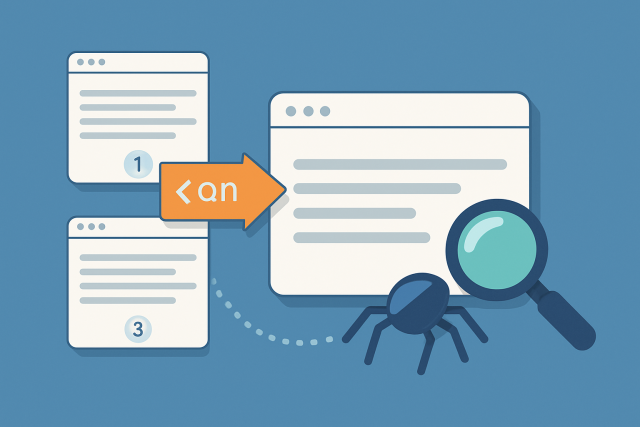
What is canonical pagination and why it matters for SEO?
Canonical pagination helps search engines identify the preferred page among multiple paginated URLs,...

A headless CMS takes the reins off traditional content management by separating the backend content repository from the frontend display layer. This approach gives developers more wiggle room to build things their own way but naturally ushers in some unique SEO challenges. The tried-and-true SEO tactics that rely on tightly coupled content and presentation often need a makeover when content is served through APIs and rendered on client-side frameworks.
Headless CMS architecture takes content and decouples it from how it looks by sending data through APIs rather than serving ready-made web pages. Unlike traditional CMS that ties content to design templates, a headless CMS calls for content to be stitched together dynamically on the frontend with JavaScript playing a big role. This separation gives frontend developers plenty of freedom to get creative.
Implementing SEO on a headless CMS comes with its fair share of challenges, like ensuring search engines can actually crawl and index content that’s rendered via JavaScript—tricky but not impossible. You also have to keep a close eye on managing meta tags and other SEO essentials on the fly, which can feel a bit like juggling while riding a unicycle.
Getting past SEO challenges with headless CMS often boils down to how savvy you are with rendering. Whether you lean on server-side rendering (SSR), prerendering or dynamic rendering, the goal is the same: making sure search engines actually see fully baked pages they can index without a hitch.
Flip the switch on server-side rendering (SSR) so your server dishes out fully rendered HTML before pages land in front of users and bots alike—kind of like prepping a meal before the guests arrive.
Get prerendering going for static routes to serve up HTML that’s ready to roll the moment a request hits—no waiting around.
Lean on dynamic rendering fallback to hand bots the rendered content while regular users enjoy the snappy client-side rendered pages.
Speed things up on the API front by caching data and trimming down payload sizes—because nobody likes to wait.
Set up smart cache invalidation so your content stays fresh as a daisy without putting the brakes on performance.
SSR and SSG give SEO a real leg up by delivering fully rendered HTML content straight to search engines so they don’t have to bother executing JavaScript in the browser. SSR cooks up pages dynamically for each request to keep content fresh and relevant. SSG does its magic ahead of time during deployment. This speeds up load times and takes a load off the server's shoulders.

Illustration showing how SSR and SSG deliver fully rendered HTML for improved SEO compared to client-side rendering
Managing SEO metadata like title tags and meta descriptions in a headless CMS depends on seamless automation between backend APIs and frontend display. It automatically pulls meta tags from content fields and adds Open Graph and Twitter cards without missing a beat. Embedding schema markup on the frontend also helps improve SEO consistency.
Whip up meta titles and descriptions on the fly by tying CMS fields directly to your frontend SEO elements. It’s like having a backstage pass to your own content.
Sprinkle in Open Graph and Twitter Card tags to give your content that extra sparkle when it pops up on social media feeds.
Weave in schema.org structured data using JSON-LD right on the frontend because it’s a sure-fire way to nudge search results into looking richer and more appealing.
Keep a keen eye on canonical URLs, making sure they stay consistent across every variation. You don’t want to trip over duplicate content issues.
Handle hreflang tags with care for international sites so your visitors always land on the language version that feels just right.
Creating clear and keyword-friendly URLs is a cornerstone for SEO and user experience in headless CMS projects. Automatically generating XML sitemaps from content APIs is a smart move because it helps search engines quickly grasp the latest site structure without missing a beat.
| URL Type | Example URL | Best Practices | Common Pitfalls |
|---|---|---|---|
| Traditional CMS URLs | /blog/how-to-optimize-seo | Use clear, descriptive paths and keywords to make it easy on everyone’s eyes | Often a bit rigid with limited wiggle room |
| Headless CMS URLs | /articles/seo-setup-headless-cms | Keep paths straightforward and relevant to the content — no need to overcomplicate | Can quickly turn into a tangled web of complexity |
| Best Practice URLs | /seo/headless-cms-setup-guide | Strive for consistency, readability, and laser-focus on keywords | Steer clear of relying too much on query strings as your main URLs |
| Poor URLs | /page?id=12345&ref=abc | N/A | Tough for both search engines and real people to make sense of |
JavaScript-driven frontends often require extra care to ensure search engines can crawl and index the content without issues. Providing a fully rendered version or fallback, fine-tuning how scripts load and running pages through tools like Google Search Console's URL Inspection are smart moves.
Organizing and structuring content thoughtfully within a headless CMS often gives your SEO efforts a nice boost. By crafting clear content models and planning internal links cleverly through APIs, reusing content thoughtfully across channels and keeping everything fresh and updated, you’re helping search engines get a sense of your site’s relevance and authority.
Set up clear and consistent content models that truly align with your SEO goals and keyword plans—think of it as laying a solid foundation before building a house.
Use API-driven navigation to dynamically optimize internal linking and spread link equity in a way that actually works, rather than just ticking boxes.
Share and reuse content across various channels thoughtfully, making sure to dodge those pesky duplicate content pitfalls.
Plan regular updates and refreshes to keep your information fresh as a daisy and search engine signals buzzing along nicely.
Keep a sharp eye on indexing status and user engagement metrics, so you can tweak and fine-tune your content strategy like a pro.
SEO optimization for headless CMS calls for constant vigilance using smart tools that can analyze the technical setup and crawling patterns. They can even test how your content is holding up in the wild.
Several top brands have hit the sweet spot with headless CMS architecture by smartly navigating some of the trickiest technical SEO hurdles. Their organic traffic jumped by a solid 30% in just half a year. Meanwhile, a media publisher decided to get clever with static site generation fine-tuned for dynamic URLs and structured data. The payoff is snappier page load times and a noticeable boost in search rankings that left competitors blinking.
"As headless architecture keeps evolving, SEO strategies really need to catch up and stay in step. Tweaking your tactics to suit this decoupled setup isn’t just helpful — it’s becoming downright essential if you want to keep your spot in search results. The case studies I have come across suggest that leaning on server-side rendering, simplifying metadata workflows, and building sturdy content models often opens the door to fresh growth opportunities, all while keeping your technical foundations rock-solid." — SEO Industry Expert
14 articles published
Driven by a passion for innovation and a deep understanding of consumer behavior, Cadence Ballantyne challenges conventional wisdom, offering fresh perspectives that inspire businesses to forge new paths in the ever-evolving digital realm.
Read Pages
Canonical pagination helps search engines identify the preferred page among multiple paginated URLs,...

Master SEO for Single Page Applications with this detailed guide covering architecture, rendering, m...

Discover essential SEO strategies tailored for single page applications to overcome unique challenge...

Wondering if a CDN can boost your SEO? This article breaks down how CDNs improve speed, security, an...